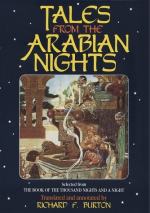[FN#271] In the Ms. v. 327, we find four hemistichs which evidently belong to Al-Mihrjan; these are:—
Hadet come to court her in fairer guise * I had given
Al-Hayfa in
bestest style;
But in mode like this hast thou wrought me wrong *
And made Envy
gibe me with jeering
smile.”
Also I have been compelled to change the next sentence, which in the original is, “And hardly had King Al-Mihrjan ended his words,” etc.
[FN#272] In this doggerel, “Kurud” (apes) occurs as a rhyme twice in three couplets.
[FN#273] “Upon the poll of his head” (’ala hamati-hi) says the Arabian author, and instantly stultifies the words.
[FN#274] Arab. “Haudaj” = a camel-litter: the word, often corrupted to Hadaj, is now applied to a rude pack-saddle, a wooden frame of mimosa-timber set upon a “witr” or pad of old tent-cloth, stuffed with grass and girt with a single cord. Vol. viii. 235, Burckhardt gives “Maksar,” and Doughty (i. 437) “Muksir” as the modern Badawi term for the crates or litters in which are carried the Shaykhly housewives.
[FN#275] In text “Sunnah” = the practice, etc., of the Prophet: vol. v. 36, 167.
[FN#276] This, as the sequel shows, is the far-famed Musician, Ibrahim of Mosul: vol. vii. 113.
[FN#277] In the text King of Al-Sin=China, and in p. 360 of Ms. Yusuf is made “King of China and Sind,” which would be much like “King of Germany and Brentford.”
[FN#278] This is the full formula repeated in the case of all the ten blessed damsels. I have spared the patience of my readers.
[FN#279] This formula of the cup and lute is decies repetita, justifying abbreviation.
[FN#280] i.e. The Beginner, the Originator.
[FN#281] The Zephyr, or rather the cool north breeze of upper Arabia, vol. viii. 62.
[FN#282] The “Full Moon”; plur. Budur: vols. iii., 228, iv., 249.
[FN#283] “Dann” = amphora, Gr. {Greek} short for {Greek} = having two handles.
[FN#284] “The large-hipped,” a form of Radih.
[FN#285] In text “Minba’ada-hu” making Jesus of later date than Imr al-Kays.
[FN#286] i.e. “The Delight”: also a P.N. of one of the Heavens: vols. iii. 19; iv. 143.
[FN#287] i.e. Joy, Contentment.
[FN#288] In text “La khuzibat Ayday al-Firak,” meaning, “may separation never ornament herself in sign of gladness at the prospect of our parting.” For the Khazib-dye see vol. iii. 105.
[FN#289] i.e. “Bloom or the Tribe.” “Zahrat"=a blossom especially yellow and commonly applied to orange-flower. In line 10 of the same page the careless scribe calls the girl “Jauharat (Gem) of the Tribe.”
[FN#290] For this Hell, see vol. viii. 111.
[FN#291] “Core” or “Life-blood of Hearts.”
[FN#292] Presently explained.
[FN#293] In text “Afrakh al-Jinn,” lit.=Chicks of the Jinns, a mere vulgarism: see “Farkh ’Akrab,” vol. iv. 46.




